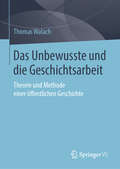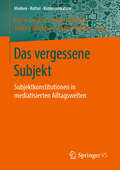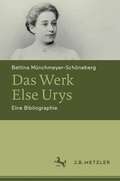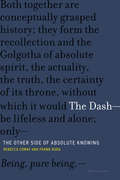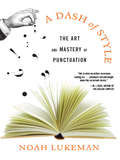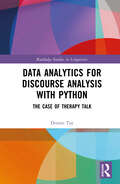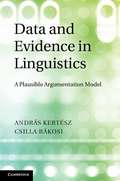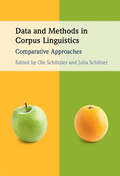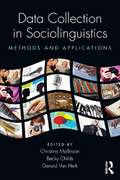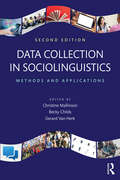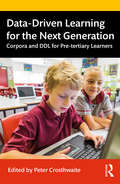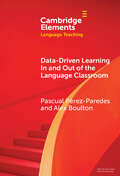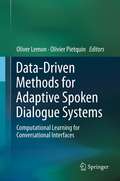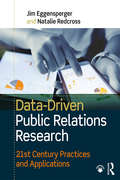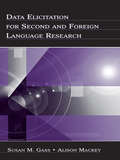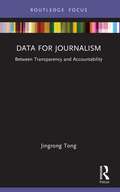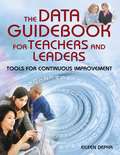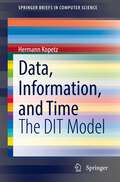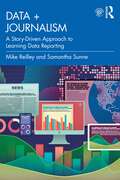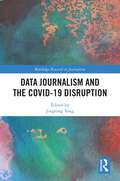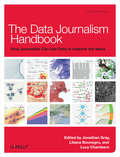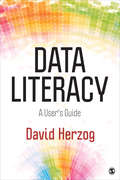- Table View
- List View
Das Unbewusste und die Geschichtsarbeit: Theorie und Methode einer öffentlichen Geschichte
by Thomas WalachDie Geschichtswissenschaft steckt in der Krise. Ist sie dabei, ihre Deutungshoheit über die Geschichte endgültig zu verlieren? Und was bedeutet das für die Zukunft der liberalen Demokratie, deren eigene Krise sich immer deutlicher abzeichnet? Zur Beantwortung dieser Fragen macht sich Thomas Walach auf die Suche nach dem Unbewussten in der Geschichte und den weitgehend unerforschten Wegen, die es mit politischer Identität und öffentlichen Geschichtsbildern verbinden. Will die Geschichtswissenschaft ihre Stimme im politischen Diskurs über Vergangenheit wiederfinden, muss sie lernen, sich mit dem historischen Unbewussten auseinanderzusetzen.Der InhaltPsychoanalyse und GeschichtswissenschaftDas historische UnbewussteDas kollektive Gedächtnis als politischer VergangenheitskonsensRevision und GeschichtsbewusstseinDie Geschichtsarbeit am WerkGesellschaft ohne GeschichteWir HistoristenWas tun? Plädoyer für eine Geschichte im Dienst der GegenwartGeschichtsarbeit als Methode der öffentlichen GeschichteNachwortDie ZielgruppenDozierende, Studierende und Praktiker aus den Fachbereichen der Geschichtswissenschaft Politikwissenschaften Soziologie Kulturwissenschaften Psychologie Bevölkerungswissenschaft Kulturwissenschaft Journalismus KommunikationswissenschaftDer AutorThomas Walach ist Universitätsassistent für die Geschichte der Neuzeit an der Universität Wien. Er lehrt und forscht zu Digitalisierung, Quellentheorie und dem Verhältnis von Geschichte und Öffentlichkeit.
Das vergessene Subjekt: Subjektkonstitutionen in mediatisierten Alltagswelten (Medien • Kultur • Kommunikation)
by Peter Gentzel Friedrich Krotz Jeffrey Wimmer Rainer WinterDer Band liefert eine kritische Bestandsaufnahme bestehender Subjektkonzeptionen der kommunikationswissenschaftlichen Forschung. Zudem werden Konzepte entwickelt um Subjektivität im Kontext aktueller theoretischer Debatten (u.a. Mediensoziologie, Cultural Studies, Psychoanalyse, Praxistheorie, Science and Technology Studies) sowie sozialer, kultureller und technischer Entwicklungen (u.a. Digitalisierung, Mediatisierung, Mobilität und Vernetzung) analysieren zu können. Da Subjektkonzeptionen für jegliche Kommunikations- und Medienanalysen von zentraler Bedeutung sind, schließt der Band eine zentrale Leerstelle der Kommunikations- und Medienwissenschaft.
Das Werk Else Urys: Eine Bibliographie
by Bettina Münchmeyer-SchönebergDie Bibliographie präsentiert erstmals in systematischer Weise Leben und Werk der bekannten jüdischen Jugendbuchautorin Else Ury (1877–1943), die vor allem durch ihre Nesthäkchen-Reihe große Popularität erlangte. Jedes Werk wird in seiner historischen und gegenwärtigen Bedeutung erläutert, es werden biographische Bezüge hergestellt, motivgeschichtliche Anmerkungen gegeben und interpretatorische Ansätze aufgezeigt. Die mehr als 1600 Einträge enthalten auch eine Reihe bisher unbekannter Erzählungen. Abbildungen im Online-Anhang erlauben die zweifelsfreie Identifizierung aller Werke. Die über zehn Register im Anhang erschlossene Arbeit bietet eine unentbehrliche Grundlage für die weitere Erforschung von Leben und Werk Else Urys.
The Dash: The Other Side of Absolute Knowing (Short Circuits)
by Rebecca Comay Frank RudaAn argument that what is usually dismissed as the “mystical shell” of Hegel's thought—the concept of absolute knowledge—is actually its most “rational kernel.” This book sets out from a counterintuitive premise: the “mystical shell” of Hegel's system proves to be its most “rational kernel.” Hegel's radicalism is located precisely at the point where his thought seems to regress most. Most current readings try to update Hegel's thought by pruning back his grandiose claims to “absolute knowing.” Comay and Ruda invert this deflationary gesture by inflating what seems to be most trivial: the absolute is grasped only in the minutiae of its most mundane appearances. Reading Hegel without presupposition, without eliminating anything in advance or making any decision about what is essential and what is inessential, what is living and what is dead, they explore his presentation of the absolute to the letter.The Dash is organized around a pair of seemingly innocuous details. Hegel punctuates strangely. He ends the Phenomenology of Spirit with a dash, and he begins the Science of Logic with a dash. This distinctive punctuation reveals an ambiguity at the heart of absolute knowing. The dash combines hesitation and acceleration. Its orientation is simultaneously retrospective and prospective. It both holds back and propels. It severs and connects. It demurs and insists. It interrupts and prolongs. It generates nonsequiturs and produces explanations. It leads in all directions: continuation, deviation, meaningless termination. This challenges every cliché about the Hegelian dialectic as a machine of uninterrupted teleological progress. The dialectical movement is, rather, structured by intermittency, interruption, hesitation, blockage, abruption, and random, unpredictable change—a rhythm that displays all the vicissitudes of the Freudian drive.
A Dash of Style: The Art and Mastery of Punctuation
by Noah Lukeman"Takes the straitjacket off punctuation....Lukeman's wit and insight make this an instant classic."--M. J. Rose The first practical and accessible guide to the art of punctuation for creative writers. Punctuation reveals the writer: haphazard commas, for example, reveal haphazard thinking; clear, lucid breaks reveal clear, lucid thinking. Punctuation can be used to teach the writer how to think and how to write. This short, practical book shows authors the benefits that can be reaped from mastering punctuation: the art of style, sentence length, meaning, and economy of words. There are full-length chapters devoted to the period, the comma, the semicolon, the colon, quotation marks, the dash and parentheses, the paragraph and section break, and a cumulative chapter on integrating them all into "The Symphony of Punctuation." Filled with exercises and examples from literary masters (Why did Poe and Melville rely on the semicolon? Why did Hemingway embrace the period?), A Dash of Style is interactive, highly engaging, and a necessity for creative writers as well as for anyone looking to make punctuation their friend instead of their mysterious foe.
Data Analytics for Discourse Analysis with Python: The Case of Therapy Talk (Routledge Studies in Linguistics)
by Dennis TayThis concise volume, using examples of psychotherapy talk, showcases the potential applications of data analytics for advancing discourse research and other related disciplines.The book provides a brief primer on data analytics, defined as the science of analyzing raw data to reveal new insights and support decision making. Currently underutilized in discourse research, Tay draws on the case of psychotherapy talk, in which clients’ concerns are worked through via verbal interaction with therapists, to demonstrate how data analytics can address both practical and theoretical concerns. Each chapter follows a consistent structure, offering a streamlined walkthrough of a key technique, an example case study, and annotated Python code. The volume shows how techniques such as simulations, classification, clustering, and time series analysis can address such issues as incomplete data transcripts, therapist–client (a)synchrony, and client prognosis, offering inspiration for research, training, and practitioner self-reflection in psychotherapy and other discourse contexts.This volume is a valuable resource for discourse and linguistics researchers, particularly for those interested in complementary approaches to qualitative methods, as well as active practitioners.
Data and Evidence in Linguistics
by András Kertész Csilla RákosiThe question of what types of data and evidence can be used is one of the most important topics in linguistics. This book is the first to comprehensively present the methodological problems associated with linguistic data and evidence. Its originality is twofold. First, the authors' approach accounts for a series of unexplained characteristics of linguistic theorising: the uncertainty and diversity of data, the role of evidence in the evaluation of hypotheses, the problem solving strategies as well as the emergence and resolution of inconsistencies. Second, the findings are obtained by the application of a new model of plausible argumentation which is also of relevance from a general argumentation theoretical point of view. All concepts and theses are systematically introduced and illustrated by a number of examples from different linguistic theories, and a detailed case-study section shows how the proposed model can be applied to specific linguistic problems.
Data and Methods in Corpus Linguistics: Comparative Approaches
by Ole Schützler Julia SchlüterCorpus linguistics continues to be a vibrant methodology applied across highly diverse fields of research in the language sciences. With the current steep rise in corpus sizes, computational power, statistical literacy and multi-purpose software tools, and inspired by neighbouring disciplines, approaches have diversified to an extent that calls for an intensification of the accompanying critical debate. Bringing together a team of leading experts, this book follows a unique design, comparing advanced methods and approaches current in corpus linguistics, to stimulate reflective evaluation and discussion. Each chapter explores the strengths and weaknesses of different datasets and techniques, presenting a case study and allowing readers to gauge methodological options in practice. Contributions also provide suggestions for further reading, and data and analysis scripts are included in an online appendix. This is an important and timely volume, and will be essential reading for any linguist interested in corpus-linguistic approaches to variation and change.
Data Collection in Sociolinguistics: Methods and Applications
by Christine Mallinson Becky Childs Gerard Van HerkThis edited volume provides up-to-date, succinct, relevant, and informative discussion about methods of data collection in sociolinguistic research. It covers the main areas of research design, conducting research, and sharing data findings with longer chapters and shorter vignettes written by a range of top sociolinguists, both veteran and emerging scholars. Here is the one-stop, go-to guide for the numerous quantitative, qualitative, and mixed methods that are used in sociolinguistic research, ensuring that Data Collection in Sociolinguistics will be not only useful in the classroom but also as a reference tool for active researchers. For more information, visit sociolinguisticdatacollection.com.
Data Collection in Sociolinguistics: Methods and Applications, Second Edition
by Christine Mallinson Becky Childs Gerard Van HerkThe second edition of Data Collection in Sociolinguistics: Methods and Applications continues to provide up-to-date, succinct, relevant, and informative discussion about methods of data collection in sociolinguistic research. Written by a range of top sociolinguists, both veteran and emerging scholars, it covers the main areas of research design, conducting research, and sharing data findings. In addition to revisions of original material, this edition includes nine new vignettes covering such topics as collecting data from social media, conducting linguistic landscape research, forensic linguistic data collection, and working with transgender communities. A companion website, http://sociolinguisticdatacollection.com, provides enhanced pedagogical features such as discussion questions, activities, end-of-chapter exercises, and contributor videos. This volume is the one-stop, go-to guide for the numerous quantitative, qualitative, and mixed methods used in sociolinguistic research; it is the ideal resource for undergraduate and graduate courses in sociolinguistic research, field methods and data collection.
Data-Driven Learning for the Next Generation: Corpora and DDL for Pre-tertiary Learners
by Peter CrosthwaiteDespite advancements in and availability of corpus software in language classrooms facilitating data-driven learning (DDL), the use of such methods with pre-tertiary learners remains rare. This book specifically explores the affordances of DDL for younger learners, testing its viability with teachers and students at the primary and secondary years of schooling. It features eminent and up-and-coming researchers from Europe, Asia, and Australasia who seek to address best practice in implementing DDL with younger learners, while providing a wealth of empirical findings and practical DDL activities ready for use in the pre-tertiary classroom. Divided into three parts, the volume's first section focuses on overcoming emerging challenges for DDL with younger learners, including where and how DDL can be integrated into pre-tertiary curricula, as well as potential barriers to this integration. It then considers new, cutting-edge innovations in corpora and corpus software for use with younger learners in the second section, before reporting on actual DDL studies performed with younger learners (and/or their teachers) at the primary and secondary levels of education. This book will appeal to post-graduate students, academics and researchers with interests in corpus linguistics, second language acquisition, primary and secondary literacy education, and language and educational technologies.
Data-driven Learning in and out of the Language Classroom (Elements in Language Teaching)
by Pascual Pérez-Paredes Alex BoultonData-Driven Learning (DDL) can be broadly defined as the use of corpus tools and techniques for learners and teachers of foreign or second language, typically in the form of concordances derived from authentic texts for inductive learning of lexicogrammar. This Element is a practical guide for language teachers and graduate students intending to explore or upgrade their use of corpora in the language classroom and beyond. In today's context, where advances in computing and information processing dominate our social and professional interactions, the use of corpora emerges as a prime resource with which to approach data-driven language learning and teaching, developing language awareness, noticing skills and critical thinking for learning that generative AI cannot do for you.
Data-Driven Methods for Adaptive Spoken Dialogue Systems: Computational Learning for Conversational Interfaces
by Oliver Lemon Olivier PietquinData driven methods have long been used in Automatic Speech Recognition (ASR) and Text-To-Speech (TTS) synthesis and have more recently been introduced for dialogue management, spoken language understanding, and Natural Language Generation. Machine learning is now present "end-to-end" in Spoken Dialogue Systems (SDS). However, these techniques require data collection and annotation campaigns, which can be time-consuming and expensive, as well as dataset expansion by simulation. In this book, we provide an overview of the current state of the field and of recent advances, with a specific focus on adaptivity.
Data-Driven Public Relations Research: 21st Century Practices and Applications
by Jim Eggensperger Natalie RedcrossThe public relations industry is undergoing a revolution in using data to define promotional programs, to measure influence and to address the needs of clients with more precision than ever. Applying tools that range from online surveys to social-media listening to applying big data with sophisticated algorithms, today’s PR professionals are data-driven in virtually everything they do. Data-Driven Public Relations Research is the first book for PR students and practitioners to offer an overview of these new practices as well as a glimpse into the future of these new applications, including "big data" and some of the applications from real-world PR campaigns and strategic planning. It includes contemporary cases involving brand name companies who are blazing new trails in the use of metrics in public relations. This book presents a practical, accessible approach that requires no prior training or experience, with easy to follow, step-by-step measurement examples from existing campaigns. Using Excel, the book enables readers to export lessons from the classroom to the office, where use of statistical packages is rare and can give PR practitioners the advantage over competitors. This pragmatic approach helps readers apply metrics to PR problems such as: Finding the best target audiences Understanding audience communication needs and preferences How best to present research outcomes How to manage major projects with specialized research firms. Accompanying electronic resources for the book include sample answers to the book’s discussion questions, PowerPoint lecture slides for instructors and sample research exercises using Excel.
Data Elicitation for Second and Foreign Language Research (Second Language Acquisition Research Ser.)
by Susan M. Gass Alison MackeyThis timely reference guide is specifically directed toward the needs of second language researchers, who can expect to gain a clearer understanding of which techniques may be most appropriate and fruitful in given research domains. Data Elicitation for Second and Foreign Language Research is a perfect companion to the same author team‘s bestsellin
Data for Journalism: Between Transparency and Accountability (Disruptions)
by Jingrong TongConsidering the interactions between developments in open data and data journalism, Data for Journalism: Between Transparency and Accountability offers an interdisciplinary account of this complex and uncertain relationship in a context of tightening the control over data and weighing transparency against privacy. As data has brought both promise and disruptive changes to societies, the relationship between transparency and accountability has become complicated, and data journalism is practised alongside the contradictory needs of opening up and protecting data. In addition to exploring the benefits of data for journalism, this book addresses the uncertain nature of data and the obstacles preventing data from being fluently accessed and properly used for data reporting. Because of these obstacles, it argues individual data journalists play a decisive role in using data for journalism and facilitating the circulation of data. Frictions in data access, newsrooms’ resources and cultures and data journalists’ skill and data literacy levels determine the degree to which journalism can benefit from data, and these factors potentially exacerbate digital inequalities between newsrooms in different countries and with different resources. As such, the author takes an international perspective, drawing on empirical research and cases from around the world, including countries such as the UK, the US, Germany, Sweden, Australia, India, China and Japan. Introducing a new dimension to the study of developments in journalism and the role of journalism in society, Data for Journalism will be of interest to academics and researchers in the fields of journalism and the sociology of (big and open) data.
Data for Journalists: A Practical Guide for Computer-Assisted Reporting
by Brant HoustonThis straightforward and effective how-to guide provides the basics for any reporter or journalism student beginning to use data for news stories. It has step-by-step instructions on how to do basic data analysis in journalism while addressing why these digital tools should be an integral part of reporting in the 21st century. In an ideal core text for courses on data-driven journalism or computer-assisted reporting, Houston emphasizes that journalists are accountable for the accuracy and relevance of the data they acquire and share. With a refreshed design, this updated new edition includes expanded coverage on social media, scraping data from the web, and text-mining, and provides journalists with the tips and tools they need for working with data.
The Data Guidebook for Teachers and Leaders: Tools for Continuous Improvement
by Eileen DepkaAre you looking for new ways to use data in the decision-making process? Are you seeking tools that provide better flow-through from data to improved student achievement? Have you ever considered including students in the data-to-improvement cycle? Schools recognize that data is an essential decision-making tool, but it requires teamwork and reflection to reap the maximum benefits. This guidebook offers practical collection and analysis methods and templates as well as tips for building trust and working together.
Data, Information, and Time: The DIT Model (SpringerBriefs in Computer Science)
by Hermann KopetzThis SpringerBrief presents the data- information-and-time (DIT) model that precisely clarifies the semantics behind the terms data, information and their relations to the passage of real time. According to the DIT model a data item is a symbol that appears as a pattern (e.g., visual, sound, gesture, or any bit pattern) in physical space. It is generated by a human or a machine in the current contextual situation and is linked to a concept in the human mind or a set of operations of a machine. An information item delivers the sense or the idea that a human mind extracts out of a given natural language proposition that contains meaningful data items. Since the given tangible, intangible and temporal context are part of the explanation of a data item, a change of context can have an effect on the meaning of data and the sense of a proposition. The DIT model provides a framework to show how the flow of time can change the truth-value of a proposition. This book compares our notions of data, information, and time in differing contexts: in human communication, in the operation of a computer system and in a biological system. In the final Section a few simple examples demonstrate how the lessons learned from the DIT-model can help to improve the design of a computer system.
Data + Journalism: A Story-Driven Approach to Learning Data Reporting
by Mike Reilley Samantha SunneTaking a hands-on and holistic approach to data, Data + Journalism provides a complete guide to reporting data-driven stories. This book offers insights into data journalism from a global perspective, including datasets and interviews with data journalists from countries around the world. Emphasized by examples drawn from frequently updated sets of open data posted by authoritative sources like the FBI, Eurostat and the US Census Bureau, the authors take a deep dive into data journalism’s "heavy lifting" – searching for, scraping and cleaning data. Combined with exercises, video training supplements and lists of tools and resources at the end of each chapter, readers will learn not just how to crunch numbers but also how to put a human face to data, resulting in compelling, story-driven news stories based on solid analysis. Written by two experienced journalists and data journalism teachers, Data + Journalism is essential reading for students, instructors and early career professionals seeking a comprehensive introduction to data journalism skills.
Data Journalism and the COVID-19 Disruption (Routledge Research in Journalism)
by Jingrong TongData Journalism and the COVID‑19 Disruption offers an international, multidisciplinary account of how and to what extent the COVID‑19 pandemic has been a blessing for data journalism.Bringing together insights into current developments in data journalism during (and since the onset of) the COVID‑19 pandemic from world‑leading data journalism practitioners and academics, this book draws on case studies and examples from different countries to critically reflect on emerging data journalism practices during the pandemic and their sustainability and implications for journalism and newsroom work in the post‑pandemic era. The chapters document changes in the practice and integration of data journalism into newsrooms and the 24/7 news cycle after the unexpected onset of the pandemic and explore how newsrooms and journalists are coping with the sudden and immense demand for data journalism and related challenges. This book also scrutinises the implications for understanding the roles played by newsroom structure and operation, the uncertain nature of data, and the relationship between journalism and other social entities such as audiences and the state in journalism’s development through times of crisis.Offering a timely contribution to the discussions on how data journalism evolved during a time of crisis, this volume will appeal to scholars and students of data journalism, journalism practice, media and communication studies, and media industry studies.
The Data Journalism Handbook: How Journalists Can Use Data to Improve the News
by Jonathan Gray Lucy Chambers Liliana BounegruWhen you combine the sheer scale and range of digital information now available with a journalist’s "nose for news" and her ability to tell a compelling story, a new world of possibility opens up. With The Data Journalism Handbook, you’ll explore the potential, limits, and applied uses of this new and fascinating field.This valuable handbook has attracted scores of contributors since the European Journalism Centre and the Open Knowledge Foundation launched the project at MozFest 2011. Through a collection of tips and techniques from leading journalists, professors, software developers, and data analysts, you’ll learn how data can be either the source of data journalism or a tool with which the story is told—or both.Examine the use of data journalism at the BBC, the Chicago Tribune, the Guardian, and other news organizationsExplore in-depth case studies on elections, riots, school performance, and corruptionLearn how to find data from the Web, through freedom of information laws, and by "crowd sourcing"Extract information from raw data with tips for working with numbers and statistics and using data visualizationDeliver data through infographics, news apps, open data platforms, and download links
Data Journalism in the Global South (Palgrave Studies in Journalism and the Global South)
by Saba Bebawi Bruce Mutsvairo Eddy Borges-ReyThis volume seeks to analyse the emerging wave of data journalism in the Global South. It does so by examining trends, developments and opportunities for data journalism in the aforementioned contexts. Whilst studies in this specific form of journalism are increasing in numbers and significance, there remains a dearth of literature on data journalism in less developed regions of the world. By demonstrating an interest in data journalism across countries including Chile, Argentina, the Philippines, South Africa and Iran, among others, this volume contributes to multifaceted transnational debates on journalism, and is a crucial reference text for anyone interested in data journalism in the ‘developing’ world. Drawing on a range of voices from different fields and nations, sharing empirical and theoretical experiences, the volume aims to initiate a global dialogue among journalism practitioners, researchers and students.
Data Literacy: A User′s Guide
by David L. HerzogA practical, skill-based introduction to data analysis and literacy We are swimming in a world of data, and this handy guide will keep you afloat while you learn to make sense of it all. In Data Literacy: A User′s Guide, David Herzog, a journalist with a decade of experience using data analysis to transform information into captivating storytelling, introduces students and professionals to the fundamentals of data literacy, a key skill in today’s world. Assuming the reader has no advanced knowledge of data analysis or statistics, this book shows how to create insight from publicly-available data through exercises using simple Excel functions. Extensively illustrated, step-by-step instructions within a concise, yet comprehensive, reference will help readers identify, obtain, evaluate, clean, analyze and visualize data. A concluding chapter introduces more sophisticated data analysis methods and tools including database managers such as Microsoft Access and MySQL and standalone statistical programs such as SPSS, SAS and R.
Data Literacy: A User′s Guide
by David L. HerzogA practical, skill-based introduction to data analysis and literacy We are swimming in a world of data, and this handy guide will keep you afloat while you learn to make sense of it all. In Data Literacy: A User′s Guide, David Herzog, a journalist with a decade of experience using data analysis to transform information into captivating storytelling, introduces students and professionals to the fundamentals of data literacy, a key skill in today’s world. Assuming the reader has no advanced knowledge of data analysis or statistics, this book shows how to create insight from publicly-available data through exercises using simple Excel functions. Extensively illustrated, step-by-step instructions within a concise, yet comprehensive, reference will help readers identify, obtain, evaluate, clean, analyze and visualize data. A concluding chapter introduces more sophisticated data analysis methods and tools including database managers such as Microsoft Access and MySQL and standalone statistical programs such as SPSS, SAS and R.
